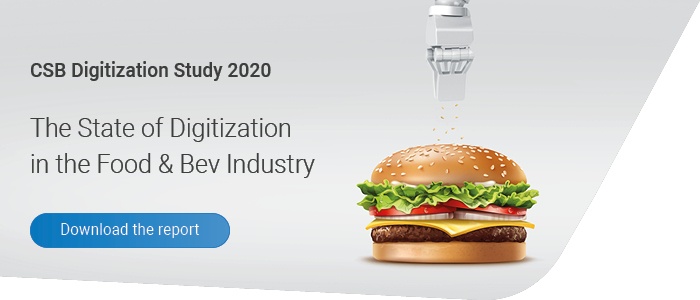Lower inventory costs - this is what nearly all food manufacturers and retailers have on their wish lists. The reasons why these high costs weigh so heavily on many enterprises vary. Many warehouses are not transparent, others are outdated with regard to the technology, and most of them are simply overcrowded. Read more on how to reduce inventory cost.
Optimize your inventory stocks
In terms of inventory cost, the first thing that comes to mind is the stock on hand and its capital commitment costs. This may sound trivial - but it is not. Actually, this is what causes the dilemma in the traditional sense: The fuller the warehouse, the higher the goods availability and, consequently, the delivery readiness. In fact, such high delivery readiness often is won at the price of too high inventory stocks and the resulting inventory management costs. On the other hand, tight stocks may easily lead to bottlenecks or even downtimes in production. The consequences of this are probably familiar to every food manufacturer and retailer. Therefore, it is vital to create transparency in the inventory, also to make so-called no-movers a thing of the past. Particularly in the food industry, it is quality and freshness of the products that count. Industry-specific ERP systems provide solutions with intelligent inventory stock monitoring and reliable forecasts of market demands. They also calculate the optimal order quantities and notify automatically as soon as the minimum stock is reached in the raw materials or dispatch warehouse. “In this way, you can achieve one hundred percent coverage of the material requirements while keeping the capital commitment as low as possible. On the bottom line, inventory costs can be reduced by about 30 percent,” explains ERP expert Björn Skupin.
Reduce the inventory risk
Be it spoilage, shrinkage or even theft your inventory is exposed to various risks that may quickly cause major financial damage. Here it is important to identify the most relevant risks and to reduce them as much as possible. In the food industry, mainly old or even spoiled goods become an economic problem. Therefore, use an inventory management system that automatically monitors the minimum shelf life of your goods in order to prevent your goods from decay. Inventory management systems that are embedded in an ERP system are especially recommended. All data from stock management, production, order management, etc. is available in one common system. This increases the transparency of processes and stocks, and it enables accurate planning of inventory processes as well as efficient processes for distribution and warehouse management.
Take advantage of new technologies in inventory logistics
Vast IT-controlled high-bay storage facilities, automatic forklifts, robot technology or smart glasses and augmented reality in picking: warehouses have arrived in Industry 4.0 and are developing into “high-tech showrooms” of the food industry. However, the digital transformation for these companies means adapting their processes in the sense of the Smart Factory. It also opens up entirely new possibilities for reducing costs, increasing competitiveness and safeguarding freshness demands. Modern technology makes food warehouses more efficient, shortens throughput and delivery times, enhances responsiveness in the case of changing demands and saves lots of money. Experts currently see two important trends: automation through robotics and provision of information on mobile devices.
Automation through robotics
For example, the Dutch company ProMessa relies on state-of-the-art robot technology in buffer and dispatch warehouses. This enables them to supply 1,200 supermarkets with a wide range of products - without having to build up large inventories: “In the past, we use to have a much larger share of buffer goods that we had to have on stock. Thanks to the speed of our logistical system, today we buffer only pre-packaged and unlabeled goods for one day,” says managing director Harold Rouweler. Daily deliveries to customers can be realized without any problems even with very short order lead times. The delivery performance currently is over 99 percent. Read here the details about how this works.
Information provision to mobile devices
Software-aided smart glasses or pick by voice solutions are replacing hand-held scanners and paper documents, thus reducing error rates and enabling higher pick performance. Food wholesaler Fripa for instance operates with voice-controlled picking, and their efficiency increased much more than they would ever have thought a few years ago. Managing director Ralf Hahl: “Quality in picking has improved considerably. As we are not using picking notes anymore in any of the areas, the error rate is close to zero. Moreover, we have become much faster. No more than 24 hours after the order has been placed we deliver the goods to the customer.”
The use of smart glasses for pick by vision is now beyond the test status, too. This technique has many advantages especially in cases of high picking density, be it in a high bay storage or ground floor picking. Current examples show time savings of approx. 18 percent while the error rate is very low.
We have compiled the optimal picking methods for manufacturers and retailers here.
Nothing goes without IT
No savings without investment in IT and state-of-the-art technologies - this also applies for the cost-intensive inventory area. Numerous examples from the field illustrate what is already possible today to work faster, better and more cost-efficient. What are the next steps? In the future, everything will be networked. Sensor technologies will be introduced for triggering supply orders automatically. RFID will be a key technology in the warehouse. Without digitization, there will be no more new leaps forward in terms of efficiency. This is also reflected at the current industry trade shows. For example, the LogiMAT, an international trade show for distribution, material and information flows in Stuttgart, ended on March 16, 2017. Its central theme: “Digital - networked - innovative”.


